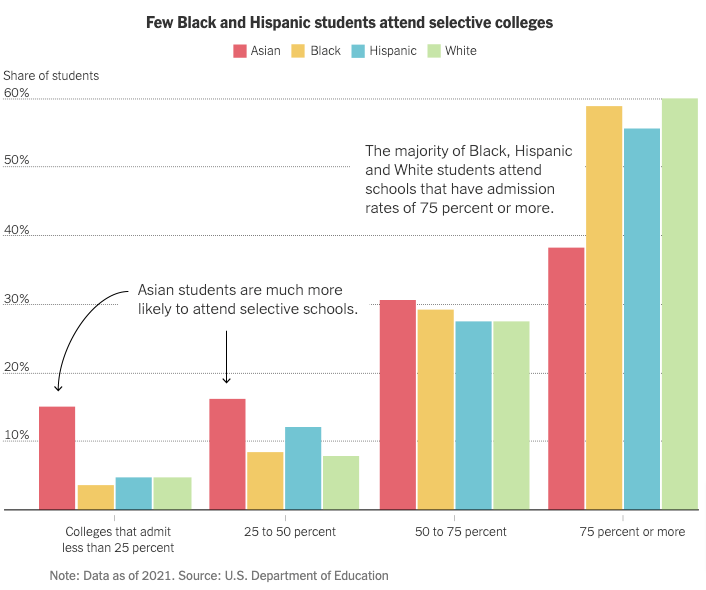For Most College Students, Affirmative Action Was Never Enough

In the wake of the Supreme Court decision that struck down race-conscious admissions, we should recognize that, in practice, affirmative action mattered a great deal for very few and very little for most.
Yes, the decision will likely dramatically reduce the racial diversity of incoming classes at highly selective institutions like Harvard, Stanford and the University of North Carolina.
But because affirmative action only opened a tiny window of access to America’s most elite institutions, the ruling will make little difference for most college students.
Even with affirmative action in place, most students of color did not go to elite colleges, and last week’s ruling does nothing to change that. The current opportunity to bring racial equity to American higher education lies in a collective re-commitment to the quality and success of more accessible institutions.
The chart below shows the racial breakdown of college attendance by admission rate for 2021. Notice how relatively few Black and Hispanic students attend schools with an admission rate of 20 percent or less.
In fact, the majority of Black and Hispanic students attend universities that accept more than three-quarters of their applicants. The exception here is Asian students, who on average are much more likely to attend elite universities. The proportion of all Asian students who attend a school with an acceptance rate under 25 percent is more than three times that of Black, Hispanic and white students.
What drives this dynamic is that most students apply to and enroll at schools near their families, regardless of whether the school is a good academic fit. We live in a country full of colleges that don’t have the resources and academic quality to match their students’ talents. Social scientists describe this problem in the college selection process as “undermatching.” Efforts to nudge students to broaden their horizons and consider attending selective colleges further from home have had only modest success.
While the Supreme Court’s decision is a blow to Black and Hispanic students who dream of attending the most competitive universities, improving and better supporting the institutions that serve the lion’s share of students of color will do far more to advance the cause of racial equality in this country than anything that admissions officers can do in Cambridge, Palo Alto and Chapel Hill.
The ruling provides America with an opportunity to redirect the conversation from a relatively small number of schools and instead direct urgently needed attention to the vast middle and lower tiers of postsecondary education. Non-selective colleges and universities can be genuine engines of economic mobility, but they do so in the face of significant headwinds.
Consider the amount of money schools report spending on student instruction each year. For example, in our state, California, U.C.L.A. and the private liberal-arts college Pomona report spending richly per student at $60,528 and $40,275, respectively. Meanwhile, less selective and more diverse institutions like San Francisco State ($8,087) and California State University, Los Angeles ($6,631), report expenditures that are less than a quarter of those amounts.
The key to greater racial equity in American higher education is elevating the quality of the broad range of schools most students attend.
Nearly 60 years ago, educators and politicians took bold and imaginative steps to take up this challenge. The Higher Education Act of 1965, enacted as part of President Lyndon B. Johnson’s War on Poverty, made college education attainable for millions of Americans who might never have dreamed of bachelor’s diplomas were it not for federal grants and loans.
States also did their part in this era, investing some of the prosperity of the post-World War II decades to create and subsidize public colleges and universities. (Historians remind us that our country accomplished these milestones at a time when colleges and universities were far more closed off to women and people of color.)
We call for that kind of bold civic action once again. This country needs to attend to the unfinished business of making college education a truly inclusive mechanism of social mobility.
Less selective schools and the millions of students they serve each year deserve the same resources and attention to program quality found in selective institutions. Affirmative action never went far enough. Winning the admissions lottery to Harvard or a selective University of California campus must not be the only path to upward mobility through higher education. All colleges, especially those serving the most diverse student bodies, should be capable of providing outcomes of similar quality.
Taking the necessary steps to do this will not be easy. State leaders will need to look hard at budget allocations that favor flagship campuses at the expense of public schools serving historically marginalized groups. They will also need to encourage colleges to improve how undergraduate education is provided and measured. Students at less selective schools should have access to programs that are well designed, adequately funded and demonstrably effective at promoting learning, graduation and meaningful employment.
Read the full piece from the Richard Arum and Mitchell L. Stevens here.
